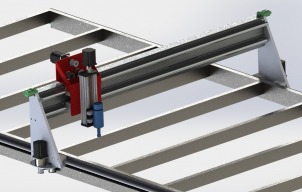RiNo Route
Discussion in 'CNC Mills/Routers' started by Steven Sampson, Sep 15, 2015.
RiNo Route
Discussion in 'CNC Mills/Routers' started by Steven Sampson, Sep 15, 2015.
A CNC router designed to handle a 4'x8' sheet, for as close to $2000 as possible. The price barrier resulted in my choice to use timing belts rather than leadscrews or rack&pinion. Build List still being updated

